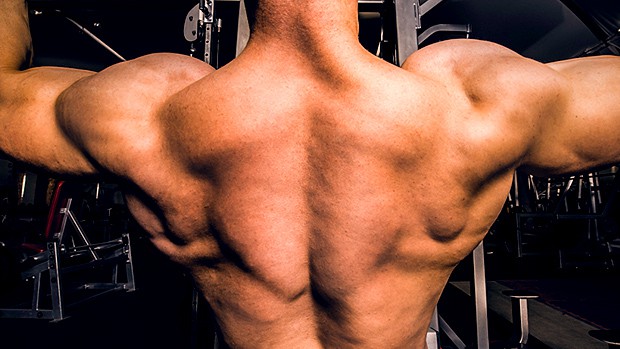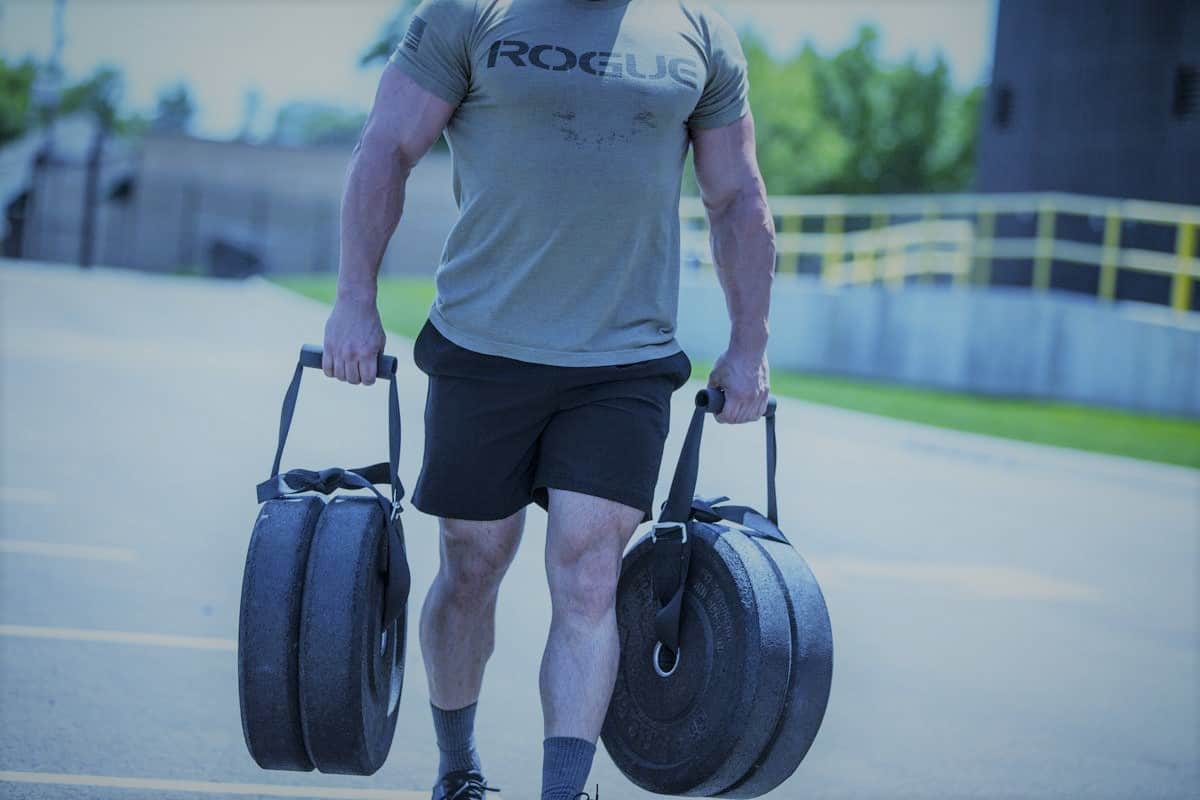When a person first starts powerlifting seriously, it’s obvious that they want to get strong. But a lot of people also want to gain size while powerlifting. Your definition of ‘big’ might be wildly different from the next guy or gal (some people dream of a Dorian Yates figure, while others would be more than happy to look like the top lifters in their height range), but if you’re just starting out, chances are you’ve thought of or entertained the fantasy of putting on some serious mass to accompany your burgeoning strength.
Chances are, you’ve also heard more than once that powerlifting is not designed to make you big. After all, hypertrophy is the realm of the bodybuilder, right? Powerlifters build ‘true’ strength, which means they don’t get that big, right?
I’ve got to ask you a serious question. What makes you think you can’t gain size while powerlifting? Have you seen a world record-breaking powerlifter with small legs? A serious bencher with puny arms or an unimpressive chest? There are exceptions to the rule – people moving crazy weight at tiny weight classes with ridiculous mobility or just the right genetics to excuse their small frames – but the general rule is that if you want to lift as much as you can, you have to work on filling out your physical frame. So yes, you can gain size from powerlifting.
Yes, But Not as Quickly as You’d Like
Here’s the thing. Most people don’t put on a lot of muscle very quickly. If you’re young, male, and didn’t draw a bad lot genetically, there’s a fairly decent chance that you’ll put on an appreciable amount of mass in your first year of training. That means going from being completely untrained, or at least having never seriously picked up a weight, to putting on quite a lot of muscle mass in your first twelve months. How big you get at first depends on your training experience, age, and genetics.
After your first year, it’ll get tougher. You might put on half that weight, or less. Then, you’ll grow at an even slower rate, until you hit your genetic potential. You can continue to gain size while powerlifting, but it gets harder.
There are guys who are gifted. They’ve got the frame (the
skeleton, basically) and the genes to pack on more than their peers. Then,
there are guys who have an incredibly hard time packing on muscle.
Some people who start out big don’t respond that well to training. A few people start out lanky but get big fast. There are all sorts of people, past the simplistic explanations of an ectomorph, mesomorph, and endomorph.
Leaving out the genetic exceptions, I could throw out there that the average joe can gain size while powerlifting in the first year, and less in the years following that first year. That is if they’re training hard enough, eating enough, and resting enough to allow their body to accumulate the necessary stimulus and recovery to grow muscle.
Unless you’re genetically gifted, however, you’re not going to grow as much or as fast as you’d want to. It’s not realistic to go from couch potato to Captain America in a year, let alone six months. You might get there in five years. It might take you ten.
It’s really, really hard. That’s not supposed to discourage
you, but it is supposed to help you avoid frustration. And who knows, maybe
you’re lucky. Maybe you’ve got the frames and genes to achieve your dream size.
But don’t count on it – and furthermore, don’t beat yourself up for it.
You Can Gain Size While Powerlifting – But Do Other Things Too
Yes, powerlifting is not about maximum muscle growth. But you’re kidding yourself if you think that isn’t an important part of it. The truth is that for your first couple of years of training, most of your gains are going to come from neural adaptations and technique improvements. Not all of them, but most.
You’re training both yourself as well as your motor neurons to more efficiently utilize muscle mass that’s already there. Yes, the stimulus is going to lead to some muscle growth. But the majority of your strength gains will come from the way your brain is recruiting your muscle fibers.
It’s complicated, but the gist of it is that as you lift more often and more intensely, your body will try to recruit more and more of its muscles for every single lift. The reason we don’t already do that is that it’s not energy efficient. Our bodies aren’t evolved to use up as much energy as they possibly can, they’re evolved to conserve energy and use it wisely. Training yourself to use as many muscle fibers as possible in a single lift takes a long time and a lot of ‘convincing’ (training at heavy weights).
But once you reach a point where those neural adaptations are only bringing in diminishing returns, how are you going to get stronger? Easy: gain size while powerlifting, through “powerbuilding”.
Most powerlifters who have been lifting for a couple of years know this, and that’s why they train to get stronger as well as bigger. Those who have already achieved maximum size are just working on getting the last few kilos they can on the bar, by improving their technique, trying to incorporate more adrenaline into each lift, or control for all of the thousand different complex factors that go into a powerlifting meet and perfect each one. At a certain point, it’s basically like drawing blood from a stone.
But for the first few years of training, both neural adaptations and muscle growth will be the driving factors behind your growing strength. While relying purely on the big three to gain size while powerlifting won’t work, that’s not how you should be training anyway.
You should be including accessories, going to failure once or twice a week on an isolation exercise, training your pullups and face pulls and reverse flies and hammer curls to keep your shoulders from rounding and to avoid elbow problems from excessive pronation. A good approach towards powerlifting requires a balanced approach, that builds both mass and strength unilaterally and works on ironing out imbalances.
Don’t Worry About Doing ‘Too Much’
If you’ve ever seen someone tell you that doing too much at the gym is killing your gains, they’re wrong. Training in a stupid way will kill your gains. For example, say you’re doing 10 sets of 10 at the same weight. Without dropping weight at any point during those 10 sets of 10, you might have achieved a ton of volume, but it’ll be at a fairly modest intensity. Is this conducive to muscle growth? Maybe. But you could be training more effectively. By balancing intensity (how close you are to a 1 rep max) and volume, you’re going to get far better results for hypertrophy.
You’re not killing your gains by doing too much – you’re just not training at an effective intensity. You need proper training stimulus to encourage your muscles to grow.
Cardio won’t kill your gains. First of all, people seriously
overestimate how much energy they’re burning when running and training. Yes, you
do speed up your metabolism and continue to burn energy even after working out,
at a higher rate than you might if you spent the whole day sitting on the
couch. But all that extra energy might amount to one or two extra Snickers
bars. We’ll get to managing your energy and caloric intakes in a little bit,
but it’s important for me to note that you shouldn’t be afraid of cardio or
training more intensely if you plan on building mass.
There is such a thing as overtraining, but it’s genuinely
pretty hard to get to that point. You’ll also likely experience a whole host of
other issues first, such as pain, tendon aches, joint problems, and you’ll be
more susceptible to catching a cold, so you might find yourself getting sick
before your training habits inhibit your gains. More often than not, it’s also
not a matter of doing too much, but a matter of doing too little
in the way of recovery.
It’s CRITICAL to sleep, first and foremost. Other methods
of recovery help reduce muscle soreness and can help minimally (which is
important when you’re an athlete, and you’ve optimized everything else
already), but for beginners, the MOST important form of recovery is sleep. At
least 7-9 hours a day.
Track Your Weight
If you’re trying to get big and lean, then you need to track
your waist and your weight. Men especially tend to accumulate not just
subcutaneous fat, but visceral fat, which hangs out around the organs, so a
mirror check isn’t always the best way to tell how much fat you’ve got.
That being said, it’s generally hard to tell what body fat percentage you’re on (even DEXA scans aren’t 100 percent accurate), but you can approximate it with this little calculator Greg Nuckols shared. It works for men and women. You’ll typically be within 3-5 percent off, but that’s a fine margin of error.
If you’re a man, and you’re interested in powerlifting, aim to be between 12 to 15 percent body fat at any given point. If you’re a woman, 20 to 25 percent is fine. Going beyond these numbers can begin to negatively impact the rate at which you grow muscle, but it also won’t do your Wilks score any favors, as fat isn’t the kind of mass that helps you lift weights. On the other hand, dropping below these numbers will make you look ‘harder’, and will help your bodybuilding prospects, but it won’t do your strength any favors.
If you aren’t already at these body fat percentages, your priority should be to continue training while getting leaner slowly. Your weekly weight loss should be no more than about 0.7 percent of your body weight, as that’s the rate of bodyweight you can stand to lose without negatively impacting your strength. Check your weight and approximate bodyfat every week until you hit your goal, then change your caloric intake to either bulk at a rate of about a pound every two weeks, or just eat at maintenance. Again, you’re missing out on potential muscle mass by continuing to just bulk while already being appreciably big.
If you aren’t losing weight, eat less. Try to modestly
increase your protein intake, because your body will start to burn
protein for energy rather than use it for muscle synthesis as you continue to
eat at a deficit. Note that this doesn’t always work. The amount of fat
you’ve packed on is also at least partially defined by your genes, and the rate
at which you lose weight (as well as how resilient your fat cells are to weight
loss) is a matter of genetics.
Some people also develop conditions that make it much harder to lose weight, due to hormone issues and other factors. Don’t lose hope here. Just reset your expectations. Aim for 20 percent body fat as a man, or 30 percent as a woman. Continue to train, don’t overeat, and just set a very long-term goal rather than aiming to lose 0.7 percent of your weight every week.
STOP BULKING AGGRESSIVELY
GOMAD and a 1000 calorie surplus is NOT the path towards gaining more muscle mass for most people. It is, however, the path towards gaining more weight. Note that if your body fat hasn’t changed but the number on the scale has shifted substantially, that doesn’t mean you’ve gained muscle. Only a modest share of the weight you gain is actually muscle. Most of it is water and sugar, which is stored inside the muscles, and retained by the body based on a couple of factors, including sodium, your hormones, creatine intake, and water intake.
Yes, some people only really start to pack on mass once they’ve got an appreciably high surplus. Given the inherent unreliability of internet calculators and calorie trackers, this doesn’t really mean that much. You need to treat all the results from these tools as approximations and trust what you can verify: your waist, your weight, and what the mirror tells you.
If you’re bulking aggressively, however, you’re just going to pack on more fat. Remember what I wrote earlier: the amount of muscle you gain is going to depend on your frame and genes, and it’ll be at its highest in your first year, with diminishing returns year after year. Resist the bro-science screaming at you to just eat more. Don’t stuff that extra cake in yourself. Don’t go ‘all in’. If you’re lean, add a couple of hundred calories and monitor your progress. If you’re making gains (a pound or more a month, if you’re a beginner), that’s good. Just keep going. Eat more if you’re no longer gaining. Eat less if you suddenly gained a ton.
Some people go so far as to say that you should just stay at maintenance and continue training. For beginners, this advice isn’t half bad – muscle stimulus, rest, and your current caloric intake are often enough to stimulate growth. But as you get closer to your muscular potential, you probably need to give your body a few extra calories. Try not to jump past 20 percent body fat if you do decide to bulk, however, and know that if you’re bulking aggressively and then cutting, you’re not gaining more muscle than you would have on a much more conservative bulk while losing out on gains you could’ve made by not having to cut.
Get Lean, or Stay Lean, and Grow Slowly
It’s simple, boring, and honestly fairly frustrating. Hit your goal body fat percentage and gain weight at a modest rate. Take your creatine, take your fish oil, get your 1.6g of protein per kg of bodyweight, watch the scale, watch the measurement band. Rinse and repeat. Week after week.
This is the reality of training for powerlifting. You need
to trust the process. Understand that there are no shortcuts. Understand that
your maximum potential – the best you could ever hope to be – is locked behind
years of hard work.
And isn’t that the best part, anyway? Where’s the appeal in
becoming the best you can be in six months? People want their instant
gratification, I get that (and there’s nothing instant about six months, to be
fair), but isn’t it so much more satisfying to stand at the summit of all
you’ve accomplished after years of sweat, blood, and tears, and look back at
where you once were with an appreciation for the commitment it took you to get
here?
At one point or another, you’ve got to sit down with
yourself and ask yourself if it’s really worth it. And if it is – if the will
to get stronger or bigger within you is so pure that you’re willing to go
through the entire process, no matter how many years it takes – then it’ll be
worth it, not eventually, not after ten years, but today, in this moment, when
you finally understand the joy of working towards a goal with purpose.
How Big Can You Get?
I conclude this little article with a link to Greg Nuckols’ excellent
guide on muscular potential. He goes over several different methods to
measure what your muscular potential might be, discusses their merits, and
leaves you with a satisfying conclusion. Don’t take it all too much to heart –
again, these are all approximations, and there’s never going to be a calculator
online that can 100 percent predict the future.




